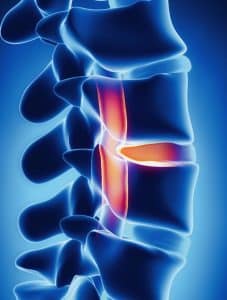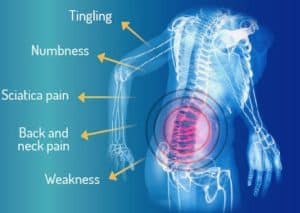By Sumaiya Farheen and Andrew Siyabalawatte, April 2023.
A slipped disc is a condition that can occur anywhere along the spine, but most often, in the lower back. This may have something to do with the weight of the upper body being distributed through to the lower back. It is sometimes called a bulging, protruding, or herniated disc. It is one of the most common causes of lower back pain, as well as leg pain, or sciatica.

Can A Chiropractor Help With A Slipped Disc?
Although a slipped disc can be very painful, the majority of people feel much better with just a few days, weeks or months of nonsurgical treatment such as seeing a chiropractor, osteopath, physiotherapist and massage therapist. Disc surgery should be considered after all nonsurgical interventions are attempted.

What is Happening When You Slip A Disc?
When a disc begins to degenerate, its jelly-like nucleus pushes against its outer ring due to wear and tear or a sudden injury. This pressure against the outer ring may cause lower back pain. If the pressure continues, the jelly-like nucleus may push all the way through disc’s outer ring or cause the ring to bulge.

This puts pressure on the spinal cord and nearby nerve roots. Not only is this a mechanical compression of the nerves, but the disc material also releases chemical irritants that contribute to nerve inflammation. When a nerve root is irritated, there may be pain, numbness, and weakness in one or both of your legs, a condition called sciatica.
Can A Prolapse Cause Back and Hip Pain?
Yes. It is not clear how a slipped disc occurs, although improper lifting and weaknesses in the spine often due to repetitive stress movements such as frequent bending are among the main contributors to a disc prolapse.

This is due to the extra pressure on the disc causing it to prolapse. Factors that may increase the risk of developing a slipped disc include: a job involving lots of lifting, a job involving lots of sitting (especially driving), weight-bearing sports (weight lifting), smoking, obesity, and increasing age (a disc is more likely to develop a weakness with increasing age).
What Does A Slipped Disc Feel Like?

Back Pain
Pain in the lower back or neck, which may be sharp, dull, or throbbing in nature.
Muscle Imbalances
Weakness in the muscles of the arms, legs, or buttocks, may impact mobility and strength and cause long term muscle imbalances.
Sensation
Tingling, numbness, or “pins and needles” sensation in the arms, legs, or other affected areas.
Limited Range Of Motion
Difficulty in moving the spine or affected areas due to pain or stiffness.
Changes In Bowel Or Bladder Function
In rare cases, disc pain may cause changes in bowel or bladder function, such as difficulty in controlling bowel movements and urinary incontinence. This a medical emergency. Visit A&E immediately if these symptoms onset suddenly.
How To Get A Slipped Disc Back In Place

Rest
One to 2 days of bed rest will usually help relieve back and leg pain. Do not stay off your feet for longer as doing so can create muscle weakness and further problems.
Exercise and Keep Going
Specific exercises will help strengthen your lower back and abdominal muscles. This may not be possible at first if the pain is very bad.
Hot and Cold
Use a cold pack immediately to reduce the pain on the affected part of the body. Heat can be incorporated once movement in the back starts to improve, usually 48 hours onwards.
Osteopathy and Chiropractic
Spinal manipulation is a proven method to alleviate pain associated with a slipped disc.
Deep Tissue
Deep Tissue Massage is an ideal option if you have a slipped disc because it uses a great deal of pressure to relieve deep muscle tension and spasms, which develop to prevent muscle motion at the affected area.
Postural Correction
Postural imbalances create weakness in various areas of the spine. This may be one of the main contributing factors to poor recovery following a slipped disc. We here at Back To Health Wellness can help you strengthen the spine by eliminating those imbalances through an evidence based treatment and exercise regime, clinically proven to help you improve your posture for the long term. Click here to book our Two Step Spinal Assessment and Treatment Promotion.

